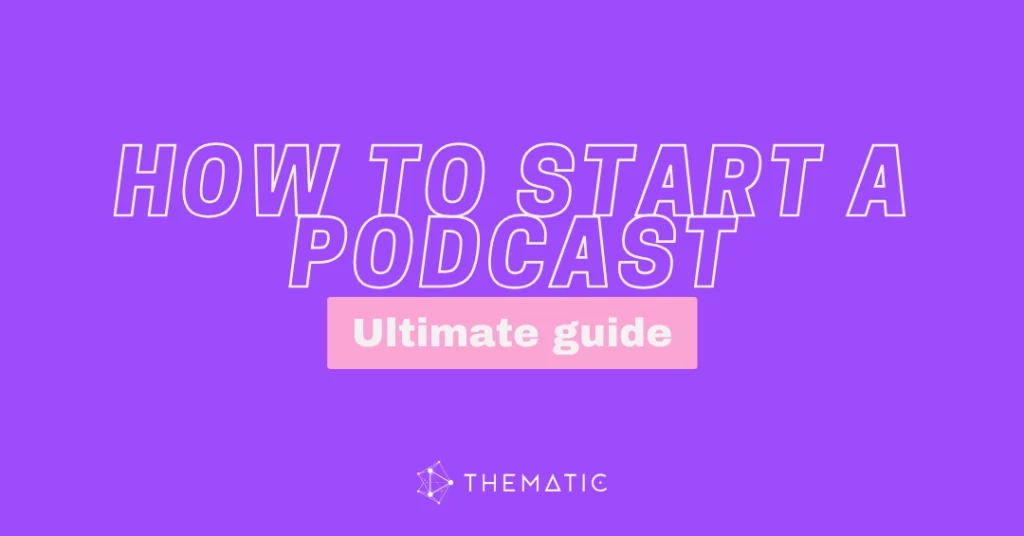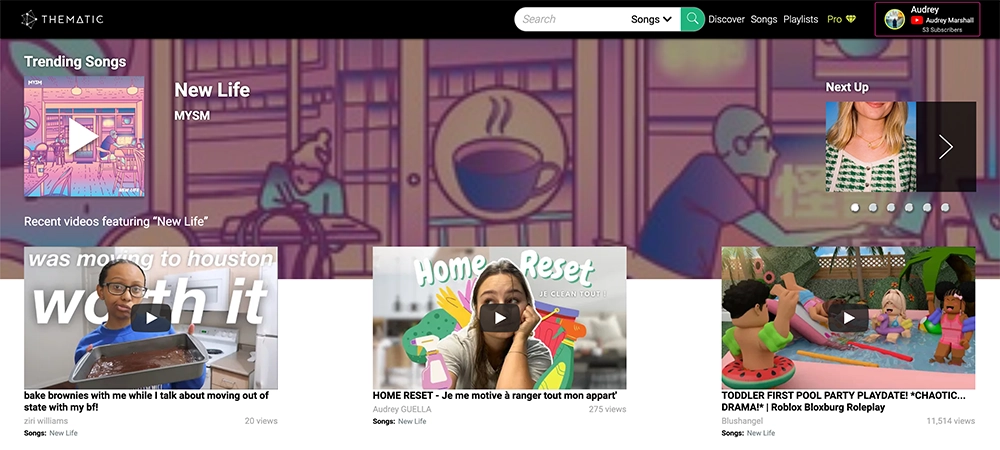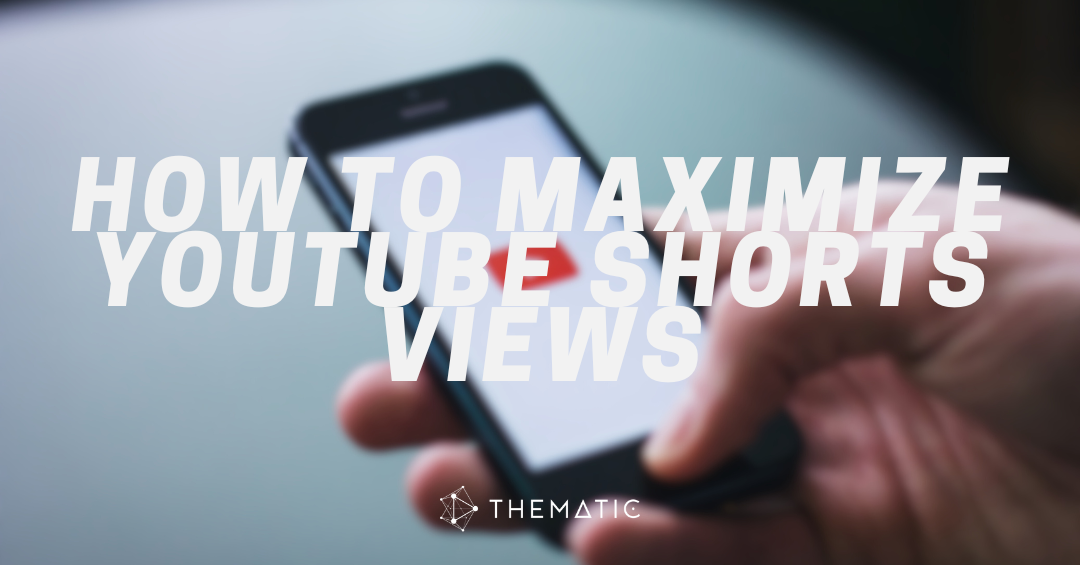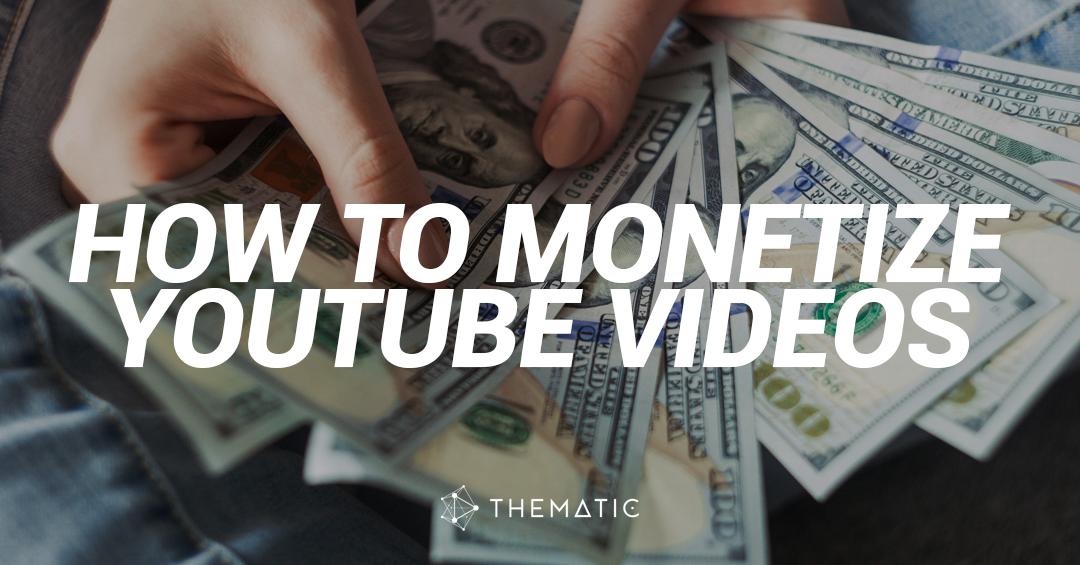
Welcome to Thematic’s comprehensive guide on how to start a podcast and tap into the incredible power of audio storytelling. Podcasting has become a global phenomenon, offering a unique platform for individuals and businesses to express their ideas, entertain audiences, and build a loyal community of listeners.
But what exactly is podcasting? Put simply, a podcast is a series of audio episodes covering a wide range of topics through interviews, narration, educational content, and more. Because they can be downloaded for offline listening or streamed online, podcasts are available to listeners anytime, anywhere.
So, should you start a podcast? Here are some of the benefits of launching a podcast:
- Reach a Global Audience: Podcasts can potentially connect you with individuals all around the world, expanding your reach beyond your town, region, or country.
- Establish Expertise: Hosting a podcast allows you to position yourself as an authority in your niche and build credibility among your target audience.
- Build a Loyal Community: Over time, your voice over the airwaves creates a connection with your audience, building a sense of familiarity and intimacy as you build a loyal listener base.
- Monetize Your Content: After you’ve grown your audience, you’ll be able to consider various monetization opportunities such as sponsorships, advertising, and merchandise sales.
Before taking a leap into the world of podcasting, make sure you truly understand your potential audience and target market. Spend some time thinking about your ideal listeners and the topics they might be interested in hearing about; this will help you tailor your content, tone, and marketing efforts to resonate with them. Consider their demographics, interests, pain points, aspirations, professional lives, and more. If your podcast is for a professional audience, it may be worthwhile to survey existing customers as well. This understanding will shape your podcast’s direction and enable you to create compelling episodes that captivate and engage your target market.
Now that we’ve covered the basics of podcasting and audience analysis, let’s explore the step-by-step process of how to start a podcast and make it a roaring success!
Table of Contents:
- Choose a Podcast Topic
- Plan Your Podcast Episodes
- Select Your Podcast Equipment & Software
- Record and Edit Episodes
- Create Podcast Artwork & Branding
- Host and Distribute Your Podcast
- Promote and Market Your Podcast
- Build an Audience and Engage with Listeners
- Monetize and Make Money from the Podcast
- Handle Legal and Copyright Considerations
Choose a Podcast Topic or Niche
Choosing the right topic or niche for your podcast is crucial. It’s the first step in your process to start a podcast and will determine the focus of your podcast and attract the audience you want to reach. Here are some steps to help you choose the perfect podcast topic:
Identify Passionate Topics or Subjects
Passion is key when it comes to choosing a podcast topic. Think about specific subjects that you could literally talk (and learn) about for hours, like a hobby, a niche interest, an industry, or anything you find exciting. Having a genuine interest in your topic will keep you motivated and make it easier to create engaging content.
Research Market Demand and Competition
Before finalizing your topic, don’t forget to research the market demand and competition in your chosen niche. Look for podcasts with similar content and evaluate their popularity and engagement. This will help you identify potential gaps in the market and differentiate your podcast.
Narrow Down the Topic or Niche
Once you have identified an exciting topic with market potential, it’s time to narrow it down further. Consider niching down your content to serve a specific segment of the larger audience and/or cater to a specific subtopic. To get established as an expert, it may be better to start small, build a dedicated audience of raving fans, and then build upon your initial success.
By following these steps, you will choose a podcast topic or niche that lights you up, has market demand, and stands out from its peers. This will increase your chances of success.
Plan and Outline Your Podcast Episodes
Define Podcast Format and Structure
Before you start a podcast, it’s essential to define the format and structure of your podcast episodes. This will help you create a consistent and engaging experience for your listeners.
Consider whether you want to have a solo podcast where you can share your thoughts and expertise alone, or if you prefer to have co-hosts or guests on your show. Think about the length of each episode and how frequently you want to release new episodes.
Brainstorm Episode Ideas and Themes
When you start a podcast, brainstorming episode ideas and themes is one of the exciting phases. Think about what topics are both relevant to your target audience and align with your podcast’s overall theme or niche. Research popular and trending subjects in your area of expertise or explore unique angles that haven’t been fully covered.
Consider creating a mind map or list to organize your episode ideas and themes. This will help you plan future episodes and ensure a variety of content that keeps your audience interested.
Create an Editorial Calendar for Consistency
An editorial calendar is a crucial tool for planning and organizing your podcast episodes. It allows you to schedule your episodes in advance, ensuring a consistent release schedule.
Start by determining how frequently you want to release new episodes, for example, once a week. Then, assign specific topics or themes to each episode, along with any special guests or segments you plan to include. Consider the overall flow and progression of your episodes to keep your audience engaged.
You can use a digital calendar or a simple spreadsheet to create your editorial calendar. Make sure to set realistic deadlines for recording, editing, and finalizing each episode. Remember, it will probably take a few tries to get the process figured out and efficient, so factor extra time especially at the beginning.
Select the Right Equipment and Software for Podcasting
Once you’ve figured out your podcast topic and episodes, you’re ready for the next step in your goal to start a podcast! Let’s explore some of the equipment and software you may need for your podcasting process.
Essential Podcasting Equipment
Sound quality is everything. Poor sound can ruin the listening experience for an otherwise great podcast.
Before you start a podcast, it’s important to gather the right equipment to ensure professional sound quality for your show. Luckily, it doesn’t have to be expensive as the prices for quality audio equipment have gone down over the years.
Here are some essential items you’ll need:
- A high-quality microphone: A good microphone can make a world of difference in the clarity and overall quality of your podcast. Look for a USB or XLR microphone that suits your budget and recording environment.
- Headphones: A reliable pair of headphones will help you monitor the audio while recording and editing your podcast episodes.
- Pop filter: This simple device helps reduce plosive sounds such as “p” and “b” sounds, making your recordings clearer.
- Microphone Stand or Boom Arm: A stand or boom arm will help you position your microphone at the correct height and angle, allowing you to maintain a consistent sound quality throughout your episodes.
- Shock Mount: A shock mount helps isolate your microphone from vibrations and handling noise, resulting in cleaner recordings.
Even with the perfect microphone and recording setup, you will most likely need to factor in a varying amount of time for editing the audio after you’ve recorded it.
Recommended Recording Software and Apps
Once you have your audio setup ready, it’s time to choose the right recording software or app. Here are some popular options:
- Audacity: Audacity is a free and open-source software that offers a range of features for recording and editing your podcast episodes.
- Adobe Audition: This professional-grade software offers advanced editing capabilities and is widely used in the podcasting industry.
- GarageBand: GarageBand is a user-friendly software available for Mac users. It offers a simple interface and intuitive controls for recording and editing your podcast.
- Anchor: Anchor is a free podcasting platform owned by Spotify that provides an all-in-one solution for recording, editing, and hosting your podcast episodes.
Understand Audio Quality and Editing Tools
When it comes to audio quality, there are a few factors to consider:
- Bitrate: Higher bitrate means better audio quality, but it also results in larger file sizes. Find a balance that suits your needs and storage capabilities.
- Sample Rate: Most podcasts use a sample rate of 44.1kHz, which is the standard for audio recordings.
- Editing Tools: Depending on the software you choose, you’ll have access to various editing tools such as noise reduction, equalization, compression, and more. Experiment with these tools to enhance the overall sound of your podcast.
By selecting the right equipment and software, you’ll be well-equipped to produce high-quality podcast episodes that your listeners will love.
Record and Edit Podcast Episodes
Now that you have your podcast topic and equipment set up, it’s time to start recording and editing your podcast episodes. This is where your content truly comes to life. In this section, we will cover everything you need to know about recording and editing your podcast episodes to ensure they sound professional and engaging.
Set Up a Recording Space
A quiet and controlled environment is crucial for recording high-quality podcast episodes. Find a room or space in your home that is free from distractions and has good sound insulation. You can also use soundproofing materials to reduce echo and external noise. Make sure your recording space is well-lit, comfortable, and has proper ventilation (but be mindful of A/C vents going off and on).
Here are a few ideas if you’re not sure where to set up. Some podcasters have started their careers in walk-in closets, some even in their cars! Others use a fully carpeted room with heavy drapes away from busy roads as their recording location. If you’re motivated and think creatively, chances are you will find a suitable place.
Proper soundproofing helps you achieve a clean sound going in and can greatly reduce time spent editing later. Same goes for using a highly rated, quality microphone, pop filter, and headphones to minimize interferences.
Conduct Interviews and Solo Recording Techniques
Depending on the format of your podcast, you may be conducting interviews or recording solo episodes. For interviews, ensure that you have a reliable audio recording software or app that can capture the voices of both you and your guest(s) clearly, and remind your guest to find a quiet location. Of course, a reliable high-speed internet connection for all participants is also important when working with a co-host or guest.
Whether you’re working solo or interacting with others, practice speaking naturally and confidently while maintaining a consistent tone and pace. Use your outline from the planning stage as a guide to structure your thoughts and avoid any unnecessary rambling.
Edit, Enhance, and Finalize Audio Episodes
Once you have finished recording your podcast episode, it’s time to edit and enhance the audio. Use editing software or apps like Audacity or Adobe Audition to remove any background noise, correct mistakes, and add intro/outro music or sound effects.
Pay attention to the overall flow and structure of your episode. Cut out any awkward pauses, excessive ums, or unnecessary tangents. Keep the editing clean and seamless to provide a polished listening experience for your audience.
Before finalizing your episode, listen to it in its entirety and make any additional adjustments or enhancements as needed. Export the audio file in a suitable format and remember to save a backup copy for future reference.
By following these recording and editing techniques, you’ll be well on your way to producing professional and engaging podcast episodes. In the next section, we will explore the importance of creating captivating artwork and branding for your podcast.
Add copyright-safe music and SFX to make your podcast come to life
When it comes to creating a podcast, adding music and sound effects can greatly enhance the listening experience for your audience. However, using copyrighted music without permission can result in legal issues and fines. To steer clear of any copyright issues, choose either royalty-free or copyright-free music from sites like Thematic.
Royalty-free music requires a one-time payment and can be used multiple times without further fees, while copyright-free music is completely free to use. You can learn more about royalty-free music here.
One great option for copyright-free music is a subscription service like Thematic, which provides a wide variety of music options, sound effects, and playlists without the worry of legal issues. By using a copyright-free music subscription service, you can not only enhance your podcast but also rest easy knowing that you’re following all the rules and regulations of music usage.
Dive into our guide on the best practices on using music in podcast episodes here.
Create Podcast Artwork and Branding
To be successful as you start a podcast, audio quality isn’t the only factor. Podcast artwork is the first thing that potential listeners see, and it plays a significant role in attracting their attention and generating curiosity. So before you officially launch your podcast, think of the brand and of the image you want to convey.
Here’s how you can create compelling podcast artwork and achieve branding consistency across different platforms:
The Importance of Professional Podcast Artwork
Your podcast content is represented by the artwork you choose; the visuals set the tone for what people will experience when listening to your show. A professional-looking cover art not only grabs attention but also conveys a sense of credibility and quality. It helps your podcast stand out from other podcasts and gets your audience excited about listening in.
Design Eye-Catching Podcast Cover Art
When designing your podcast cover art, consider the following tips:
- Use high-quality images or illustrations that are relevant to your podcast topic.
- Choose colors and fonts that align with your podcast’s theme and tone.
- Keep the design clean and uncluttered, ensuring that text is easily readable.
- Create a visually striking and memorable logo or icon that represents your podcast.
Establish Brand Consistency Across Platforms
When publishing your podcast across different platforms, consistency is key to brand recognition. Ensure that your podcast artwork looks the same on each platform, no matter if it’s iTunes, Spotify, or any other podcast directory. It helps to build recognition and makes it easier for potential listeners to find and recognize your podcast.
Additionally, consider using the same color scheme, fonts, and overall design elements across your podcast’s website and social media profiles. Uniformity strengthens brand recognition and helps your podcast become known more quickly.
Host and Distribute the Podcast to Various Platforms
Once you have recorded and edited your podcast episodes, it’s time to host and distribute them to various platforms. This step is crucial for reaching a wider audience and making your podcast easily accessible.
Select a Podcast Platform
When selecting a podcast platform, you should consider the following:
- Ease of use: The platform should be user-friendly, and easy to navigate so that you can upload and publish your episodes quickly and efficiently.
- Distribution: The platform should offer easy distribution to all major podcast directories such as Apple Podcasts, Spotify, and Google Podcasts.
- Analytics: The platform should provide detailed analytics to help you understand your listenership, such as the number of downloads, plays, and subscribers.
- Customization: The platform should allow you to customize your podcast’s branding, including artwork, titles, and descriptions.
- Monetization: The platform should offer monetization options such as sponsorships, advertising, or premium content, so you can earn revenue from your podcast.
- Cost: The platform should fit within your budget, whether it’s free or paid. Some platforms may take a percentage of your revenue, so consider this as well.
- Support: The platform should offer good customer support, including resources, tutorials, and assistance if you encounter any issues.
Popular Podcast Distribution Sites
The following platforms can help you host and distribute your podcast:
- Anchor: Anchor is a free all-in-one podcast hosting and distribution platform that offers easy-to-use tools, customizable branding, and monetization options. It also offers advanced analytics and distribution to all major podcast directories.
- Buzzsprout: Buzzsprout is a popular podcast hosting and distribution platform that offers a user-friendly interface, easy-to-use tools, and integration with all major podcast directories. It offers a free plan with limited storage and paid plans with more features.
- Libsyn: Libsyn is a leading podcast hosting and distribution platform that offers robust features such as unlimited storage, advanced analytics, and monetization options. It offers a range of pricing plans based on the storage and features you need.
- Podbean: Podbean is a user-friendly podcast hosting and distribution platform that offers unlimited storage, customizable branding, and monetization options. It offers a free plan with limited storage and paid plans with additional features.
- Transistor: Transistor is a powerful podcast hosting and distribution platform that offers unlimited storage, advanced analytics, and team collaboration tools. It offers pricing plans based on the number of shows and downloads.
- Captivate: Captivate is a podcast hosting and distribution platform that offers unlimited storage, advanced analytics, and customizable branding. It offers pricing plans based on the number of downloads and features you need.
- Simplecast: Simplecast is a podcast hosting and distribution platform that offers advanced analytics, customizable branding, and monetization options. It offers pricing plans based on the number of shows and downloads.
Each of these platforms has its own strengths and weaknesses, so it’s important to evaluate them based on your specific needs and goals.
Promote and Market Your Podcast
Now that you’ve created and published your podcast, you can accelerate audience growth through marketing and promotional initiatives. Below are some effective strategies to consider, but don’t worry; you don’t have to do them all at the same time. It’s better to choose one channel and do it well, then move on to the next, rather than try to do everything at once and not being as effective.
Leverage Social Media to Increase Visibility
Social media platforms are a good way to promote your podcast and engage with your desired audience. Consider these tips to increase your podcast’s visibility:
- Share snippets or highlights from your podcast episodes on platforms like Instagram, Facebook, and Twitter.
- Engage with your audience by responding to comments, questions, and feedback on social media.
- Create eye-catching visuals or graphics related to your podcast episodes to pique curiosity.
- Collaborate with other podcasters or influencers in your niche for cross-promotion opportunities.
Create Engaging Teasers, Trailers, and Promotional Content
Teasers and trailers are a great way to generate excitement and give potential listeners a taste of what your podcast offers. Consider these strategies:
- Create short teaser clips that highlight intriguing moments or quotes from your podcast episodes.
- Design visually appealing and informative trailers that provide an overview of your podcast’s content.
- Develop promotional content, such as blog posts or articles, that discuss the topics covered in your podcast.
- Utilize your podcast’s branding, including the artwork and logo, in all promotional materials.
Collaborate with Influencers and Cross-Promotion Opportunities
Collaborating with influencers and seeking cross-promotion opportunities can significantly expand your podcast’s reach. Here’s how to make the most of these opportunities:
- Identify influencers or established figures in your industry or niche who have a substantial following.
- Offer a personalized pitch to each influencer, highlighting the value and uniqueness of your podcast to their audience.
- Depending how well-established they are, they may have many collaboration offers, so make sure your message is not generic but truly customized.
- Offer guest appearances or interviews, allowing the influencer to share their insights on your podcast.
- Think of cross-promotion opportunities: find other podcasts that serve a similar audience to yours, then offer a guest spot on your podcast in exchange for you appearing on theirs.
- Consider participating in podcast networks.
Patience is key in the beginning. After you’ve established your podcast’s audience and credibility, collaborations will become easier to set up. Keep trying until you find the people that want to work with you.
Build an Audience and Engage with Listeners
Once you have started your podcast and published a few episodes, the next crucial step is to build an audience and engage with your listeners. Here are some strategies to help you grow your podcast and connect with your audience:
Importance of Audience Engagement and Relationship Building
Connecting with your audience is essential for building a loyal fan base. When your listeners relate to you and your content, they are more likely to become avid listeners and share your podcast with coworkers, friends and family. Here are a few ways to engage with your audience:
- Respond to listener feedback: Take the time to respond to comments and messages from your listeners. Make them feel heard and appreciated.
- Encourage listener participation: Pose questions or ask for feedback in your episodes to encourage your audience to actively participate.
- Create a sense of community: Develop a community around your podcast by hosting online forums or discussion groups where listeners can connect with each other and with you.
Use Listener Feedback and Questions for Episode Inspiration
Your listeners can be a valuable source of inspiration for your podcast episodes. Pay attention to their feedback and questions, as they can provide insights into what topics or aspects of your podcast resonate with them. Consider incorporating listener-suggested topics into your episodes.
Facilitate Community Engagement and Interaction
Building a community around your podcast can greatly enhance the overall experience for your listeners. Here are a few ways to facilitate community engagement:
- Host live Q&A sessions: Schedule live sessions where you can answer questions from your audience in real-time.
- Collaborate with your listeners: Invite listeners to contribute to your podcast by featuring their stories, experiences, or expertise.
- Encourage listener-generated content: Motivate your audience to share their own content related to your podcast, such as fan art or personal stories.
Remember, building an audience and engaging with listeners takes time and effort. Stay consistent with your podcasting schedule, deliver valuable content, and make it a top priority to create a genuine connection with your audience.
Monetize and Make Money from the Podcast
Understand Different Monetization Strategies and Models
When it comes to monetizing your podcast, there are various strategies to explore. Here are a few common approaches:
- Premium Content: Creating exclusive episodes or bonus content that can be accessed only by paid subscribers.
- Donations and Crowdfunding: Setting up a platform for listeners to support your podcast financially.
- Sponsored Content: Partnering with brands or businesses who are willing to pay for advertising on your podcast.
- Affiliate Marketing: Promoting products or services that align with your podcast’s niche and earning a commission for every sale made through your referral.
Sponsorships, Advertisements, and Partnerships
Once your podcast has reached some level of credibility as well as a sizeable audience (which will depend on several factors including your niche and the size of your target market) you might be ready for sponsorships and advertisements.
Here are some steps to consider:
- Think about your audience. Based on what you know about them at this juncture, what kind of products or services might they be interested in?
- Reach out to potential sponsors: Identify brands that align with your podcast’s niche and create a compelling sponsorship proposal outlining why they would want to reach your audience.
- Negotiate terms and rates: Discuss the details of the sponsorship agreement, including pricing, duration, and promotional requirements.
- Create engaging ad spots: Design advertisements that seamlessly integrate with your podcast episodes and resonate with your audience.
- Track and analyze results: Monitor the performance of your sponsored content and provide feedback to sponsors based on the engagement and conversions generated.
Additional Revenue Generation Opportunities (merchandise, courses, etc.)
In addition to sponsorships, there are other opportunities to generate revenue from your podcast. Similar to sponsorships, these additional revenue generating opportunities should be considered after you’ve established a loyal fan base.
Here are some ways to generate revenue for your popular podcast:
- Merchandise: Create branded merchandise, such as t-shirts, mugs, or stickers, and sell them to your listeners.
- Courses or Consultations: Share your expertise by offering online courses or personalized consultations related to your podcast’s niche.
- Events and Workshops: Organize live events or workshops where your audience can attend and learn from you in person.
- Patreon or Membership Programs: Provide exclusive perks and benefits to dedicated supporters through subscription-based platforms like Patreon.
Handle Legal and Copyright Considerations in Podcasting Creation and Distribution
As a budding podcaster, you may be new to all the legal and copyright considerations of creating and distributing your content. Below, we’ve listed the most critical issues to be aware of and avoid.
Intellectual Property Rights and Fair Use
When creating a podcast, always consider the intellectual property rights of others and avoid using copyrighted materials such as music, audio clips, or images. For example, you could get in legal hot waters by downloading someone else’s art from the internet and using it in your podcast artwork. Note that in a few limited cases, the “fair use doctrine” may apply. This doctrine allows for limited use of copyrighted material for purposes such as commentary, criticism, or within educational settings.
Copyrighted Materials and Obtaining Necessary Permissions
If including copyrighted material is vital to your podcast goals, play it safe and obtain the necessary permissions from the copyright holder. This may involve contacting the creator or publisher directly or obtaining a license to use the material in your podcast. It is always best to err on the side of caution and seek legal advice if unsure about the legality of using specific materials. You don’t want your podcast to become very successful only to later end up in court over an expensive copyright dispute.
Ensure Privacy and Compliance with Regulations
Privacy is an essential consideration in podcasting. When interviewing guests or discussing sensitive topics, always obtain consent from the individuals involved.
It’s also good to stay updated on, and comply with, any relevant regulations such as data protection laws, especially if you collect any personal information from listeners (e.g., on a contact form).
How Thematic helps you be compliant

Whether it’s an intro/outro, background music, or sound effects you’re looking for (or all of the above), signing up with Thematic can really help you put the copyright worries aside.
- 100% free of copyright problems
- $0 royalties due
- A huge music library to choose from
- Unlimited downloads and personal playlists
- Super affordable podcast-level subscription
Discover some of our favorite copyright-free music for podcasts in our Top 10 Royalty-Free Songs for Podcasts list here or browse some of our curated podcast music playlists here.
If you’re ready to level-up your podcast soundtrack with great royalty-free music and join a collaborative and thriving community of creators, sign-up for a free Thematic account today.
We hope you enjoyed our ultimate guide on how to start a podcast ✌️If you’re looking for more creator tools and resources, visit Thematic’s Creator Toolkit for additional resources on creating content – including starting a YouTube channel, thumbnail and channel art templates, best practices, and of course, great royalty free songs to use in your videos for free with Thematic.

This Ultimate Guide on How to Start a Podcast is brought to you by Thematic Director of Partnerships, Stephanie Leyva
Stephanie Leyva sits at the intersection of music artists and content creators. As the Director of Partnerships at Thematic, Stephanie has worked extensively with the artist and creator community on the site to ensure success digitally, on the platform, and support their initiatives.
Over the past few years, she has led numerous trending music-driven influencer marketing campaigns for “Glitter” and “Supalonely (feat. Gus Dapperton” by BENEE, “Loneliness for Love” by Lovelytheband, “Checklist (feat. Chromeo)” by MAX and so many more. She’s worked alongside various labels such as Casablanca Records, Republic Records and Sony Music. Focused on empowering connections between content creators and music artists, Stephanie continues to lead the charge in innovative music discovery through social.
Stephanie is also the creator of the Bloom In Progress podcast – a podcast about personal growth, relationships and navigating life in your 20’s.



